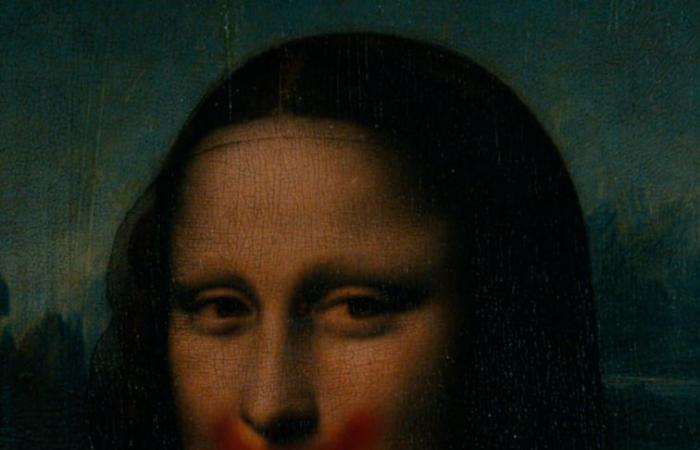Are today’s madmen yesterday’s madmen? This is one of the many questions that the new great The Louvre’s autumn exhibition “Figures of the Madman. From the Middle Ages to the Romantics” aims to answer from October 16, 2024.
On October 2, 2024, Warner Bros. Pictures presents the film JOKER: MAD FOR TWO, directed by Todd Philipps and bringing together Joaquin Phoenix and Lady Gaga on screen.
At the invitation of the Louvre and in close collaboration with the museum teams, in partnership with Lady Gaga, Warner Bros created an original video shot in the museum’s rooms, featuring Lady Gaga.
Inspired by her character Lee Quinzel, Lady Gaga enters the rooms of the Louvre museum, as in a dream, to live a Folie for two with the most iconic of works of art, Mona Lisa.
The Mona Lisa lends itself to a new diversion around its famous smile, the time of a reinterpretation of one iconic scenes from the movie JOKER: FOLLY A DEUX by Lady Gaga.
THE FIGURE OF THE MADMAN, A FASCINATING AND SUBVERSIVE FIGURE
This fall, the Louvre Museum is dedicating a unique exhibition to the many figures of the madman, which abound in the visual universe of the 13th century.e in the 16th centurye century. Illuminated manuscripts, printed books and engravings, tapestries, paintings, sculptures, precious or everyday objects: between the Middle Ages and the Renaissance, the madman literally invades the entire artistic space and imposes himself as a fascinating, disturbing and subversive figure in an era of ruptures, not so far from ours. Capable of the best as well as the worst, the madman is in turn the one who entertains, warns, denounces, reverses values, or even overthrows the established order.
The exhibition also explores the disappearance of the madman when Reason and Enlightenment triumphed, before a resurgence at the end of the 18th century.e century and throughout the 19th centurye century. The madman then becomes the figure with which artists identify: “What if the madman was me?” Today the figure of the madman finds new resonances in our contemporary sensibilities, notably through that of the Joker who is a contemporary interpretation.
THE MONA LISA, A STILL CONTEMPORARY ICON
Although this is obviously pure fiction, created with a device that guarantees the perfect integrity and security of the work, the Louvre takes a reflective look at the status of the work through this creation. Mona Lisaan icon of the Louvre Museum which has been protected by armoured glass since 1974. Copied, reinterpreted and diverted many times, it has become a contemporary icon over time.
Celebrated since its creation at the beginning of the 16th centurye century for its striking ability to imitate both physical and psychological life, the Mona Lisa naturally lends itself to this diversion around the smile.
Leonardo da Vinci favored in his painted works this human expression par excellence, fleeting and ambiguous, which allows him to capture a movement in progress and to create a dialogue with the viewer. The importance of this face-to-face in the composition created by the Florentine master is at the heart of the video.
THE LOUVRE MUSEUM, A PLACE OF INSPIRATION AND AUDACITY FOR ALL ARTISTS
The Louvre is the contemporary place of art, a place of pleasure and audacity that nourishes the creativity of all artists. It offers an infinite playground for dialogue between cultures (from classical culture to pop culture) and the arts (fine arts, cinema, music, dance, etc.).
The exhibition “Figures of the Mad. From the Middle Ages to the Romantics” is part of a broader “Crazy Season”, embodied by a rich and unique cultural program: with in particular a creation by François Chaignaud entitled “Petites joueuses” – a piece in the form of an immersive and continuous journey through the medieval Louvre – or a “Night of the Mad”, a contemporary carnival between dances, music and performances with the presence of artists such as Zaho de Sagazan and Arthur H.
JOKER: MADNESS FOR TWO in theaters, from October 2, 2024
“Figures of the Madman. From the Middle Ages to the Romantics”, at the Louvre Museum, from October 16, 2024 to February 3, 2025
THE MONA LISA
This painting, begun around 1503, probably for Francesco del Giocondo, a Florentine gentleman (1460-1539), was kept by Leonardo da Vinci, who continued its pictorial execution until his death in 1519 but left it unfinished. It was acquired by Francis I in 1518.
Leonardo depicts Francesco del Giocondo’s wife as a virtuous woman, but without the distant, even haughty expression of ancient and contemporary representations. Seated in a loggia on the edge of a vast landscape of lakes and mountains, Lisa Gherardini turns towards us and smiles with a naturalness that is forever incomparable. This welcoming smile, with its lively intelligence, creates an immediate and very effective communication with the viewer. The sfumato effect – the evaporation of contours in shadow and light – here reaches its ultimate accomplishment, and the divine science of painting the fullness of its vocation: the imitation of life itself.
At the time of its creation, this smile could also be interpreted as an onomastic play: “Giocondo” means “happy” in Italian. La Gioconda is therefore a happy woman whose natural attribute is the smile. The Joker and the Mona Lisa share the same etymology: “Jocus” in Latin. A coincidence that the Louvre Museum is offering to play with.
Even during Leonardo da Vinci’s lifetime, the Mona Lisa was admired by his contemporaries. Glorified in 1550 by the art historian Giorgio Vasari, who made it a masterpiece among masterpieces and a symbol of the power of painting, it was known to all art lovers who ordered painted copies or, later, bought engravings and photographs.
During the 19th century, the Mona Lisa was no longer just a marvel of painting but became the object of fascination. Great writers, such as George Sand, Théophile Gautier, Jules Verne and Oscar Wilde, marveled at Lisa’s charm and were enchanted by her mysterious smile. Artists were also not immune to the spell and tried to equal or even surpass Leonardo. In the 20th century, like Marcel Duchamp who gave the icon a moustache, with this irreverent title: LHOOQ (meaning of course: she’s got a hot ass), they ended up mocking or attacking the masterpiece which became ever more famous.
Its theft in 1911 brought it worldwide and popular notoriety, which has never waned and the image of the painting has continued to spread across the planet. Its fame has grown since the second half of the 20th century, which also saw the emergence of a number of wacky and esoteric theories about it, the polar opposite of the luminous art of Leonardo da Vinci. The face of the Mona Lisa still inspires artists, particularly in the new expressions of street art, reinforcing its status as a pop culture icon.






